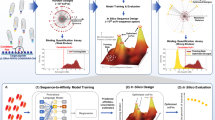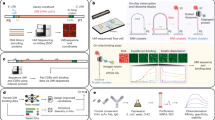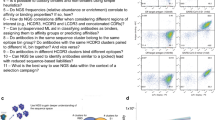Abstract
Antibody discovery typically uses hybridoma- or display-based selection approaches, which lack the advantages of directly screening spatially addressed compound libraries as in small-molecule discovery. Here we apply the latter strategy to antibody discovery, using a library of ∼10,000 human germline antibody Fabs created by de novo DNA synthesis and automated protein expression and purification. In multiplexed screening assays, we obtained specific hits against seven of nine antigens. Using sequence-activity relationships and iterative mutagenesis, we optimized the binding affinities of two hits to the low nanomolar range. The matured Fabs showed full and partial antagonism activities in cell-based assays. Thus, protein drug leads can be discovered using surprisingly small libraries of proteins with known sequences, questioning the requirement for billions of members in an antibody discovery library. This methodology also provides sequence, expression and specificity information at the first step of the discovery process, and could enable novel antibody discovery in functional screens.
This is a preview of subscription content, access via your institution
Access options
Subscribe to this journal
Receive 12 print issues and online access
$209.00 per year
only $17.42 per issue
Buy this article
- Purchase on Springer Link
- Instant access to full article PDF
Prices may be subject to local taxes which are calculated during checkout





Similar content being viewed by others
References
Kohler, G. & Milstein, C. Continuous cultures of fused cells secreting antibody of predefined specificity. Nature 256, 495–497 (1975).
Jin, A. et al. A rapid and efficient single-cell manipulation method for screening antigen-specific antibody-secreting cells from human peripheral blood. Nat. Med. 15, 1088–1092 (2009).
Love, J.C., Ronan, J.L., Grotenbreg, G.M., van der Veen, A.G. & Ploegh, H.L. A microengraving method for rapid selection of single cells producing antigen-specific antibodies. Nat. Biotechnol. 24, 703–707 (2006).
Hoogenboom, H.R. Selecting and screening recombinant antibody libraries. Nat. Biotechnol. 23, 1105–1116 (2005).
Huse, W.D. et al. Generation of a large combinatorial library of the immunoglobulin repertoire in phage lambda. Science 246, 1275–1281 (1989).
McCafferty, J., Griffiths, A.D., Winter, G. & Chiswell, D.J. Phage antibodies: filamentous phage displaying antibody variable domains. Nature 348, 552–554 (1990).
Hanes, J., Jermutus, L., Weber-Bornhauser, S., Bosshard, H.R. & Pluckthun, A. Ribosome display efficiently selects and evolves high-affinity antibodies in vitro from immune libraries. Proc. Natl. Acad. Sci. USA 95, 14130–14135 (1998).
Boder, E.T. & Wittrup, K.D. Yeast surface display for screening combinatorial polypeptide libraries. Nat. Biotechnol. 15, 553–557 (1997).
Beerli, R.R. et al. Isolation of human monoclonal antibodies by mammalian cell display. Proc. Natl. Acad. Sci. USA 105, 14336–14341 (2008).
Ho, M., Nagata, S. & Pastan, I. Isolation of anti-CD22 Fv with high affinity by Fv display on human cells. Proc. Natl. Acad. Sci. USA 103, 9637–9642 (2006).
Levitan, B. Stochastic modeling and optimization of phage display. J. Mol. Biol. 277, 893–916 (1998).
Wang, L., Martin, B., Brenneman, R., Luttrell, L.M. & Maudsley, S. Allosteric modulators of g protein-coupled receptors: future therapeutics for complex physiological disorders. J. Pharmacol. Exp. Ther. 331, 340–348 (2009).
Fodor, S.P. et al. Light-directed, spatially addressable parallel chemical synthesis. Science 251, 767–773 (1991).
Ziauddin, J. & Sabatini, D.M. Microarrays of cells expressing defined cDNAs. Nature 411, 107–110 (2001).
Diller, D.J. The synergy between combinatorial chemistry and high-throughput screening. Curr. Opin. Drug Discov. Devel. 11, 346–355 (2008).
Polinsky, A. Combichem and chemoinformatics. Curr. Opin. Drug Discov. Devel. 2, 197–203 (1999).
Kauffman, S.A. . The Origins of Order (Oxford University Press; 1993).
Bachmann, M.F., Kundig, T.M., Kalberer, C.P., Hengartner, H. & Zinkernagel, R.M. How many specific B cells are needed to protect against a virus? J. Immunol. 152, 4235–4241 (1994).
Cohn, M. & Langman, R.E. The protection: the unit of humoral immunity selected by evolution. Immunol. Rev. 115, 11–147 (1990).
Xu, J.L. & Davis, M.M. Diversity in the CDR3 region of V(H) is sufficient for most antibody specificities. Immunity 13, 37–45 (2000).
Babor, M. & Kortemme, T. Multi-constraint computational design suggests that native sequences of germline antibody H3 loops are nearly optimal for conformational flexibility. Proteins 75, 846–858 (2009).
Patten, P.A. et al. The immunological evolution of catalysis. Science 271, 1086–1091 (1996).
Sethi, D.K., Agarwal, A., Manivel, V., Rao, K.V. & Salunke, D.M. Differential epitope positioning within the germline antibody paratope enhances promiscuity in the primary immune response. Immunity 24, 429–438 (2006).
Thielges, M.C., Zimmermann, J., Yu, W., Oda, M. & Romesberg, F.E. Exploring the energy landscape of antibody-antigen complexes: protein dynamics, flexibility, and molecular recognition. Biochemistry 47, 7237–7247 (2008).
Yin, J., Beuscher, A.E.t., Andryski, S.E., Stevens, R.C. & Schultz, P.G. Structural plasticity and the evolution of antibody affinity and specificity. J. Mol. Biol. 330, 651–656 (2003).
Zimmermann, J. et al. Antibody evolution constrains conformational heterogeneity by tailoring protein dynamics. Proc. Natl. Acad. Sci. USA 103, 13722–13727 (2006).
Nguyen, H.P. et al. Germline antibody recognition of distinct carbohydrate epitopes. Nat. Struct. Biol. 10, 1019–1025 (2003).
Thomson, C.A. et al. Germline V-genes sculpt the binding site of a family of antibodies neutralizing human cytomegalovirus. EMBO J. 27, 2592–2602 (2008).
Matsuda, F. et al. The complete nucleotide sequence of the human immunoglobulin heavy chain variable region locus. J. Exp. Med. 188, 2151–2162 (1998).
Smider, V. & Chu, G. The end-joining reaction in V(D)J recombination. Semin. Immunol. 9, 189–197 (1997).
Gilfillan, S., Benoist, C. & Mathis, D. Mice lacking terminal deoxynucleotidyl transferase: adult mice with a fetal antigen receptor repertoire. Immunol. Rev. 148, 201–219 (1995).
Holt, L.J., Bussow, K., Walter, G. & Tomlinson, I.M. By-passing selection: direct screening for antibody-antigen interactions using protein arrays. Nucleic Acids Res. 28, E72 (2000).
Corbett, S.J., Tomlinson, I.M., Sonnhammer, E.L., Buck, D. & Winter, G. Sequence of the human immunoglobulin diversity (D) segment locus: a systematic analysis provides no evidence for the use of DIR segments, inverted D segments, “minor” D segments or D-D recombination. J. Mol. Biol. 270, 587–597 (1997).
Brezinschek, H.P. et al. Analysis of the human VH gene repertoire. Differential effects of selection and somatic hypermutation on human peripheral CD5(+)/IgM+ and CD5(−)/IgM+ B cells. J. Clin. Invest. 99, 2488–2501 (1997).
Kim, D. et al. Directed evolution and identification of control regions of ColE1 plasmid replication origins using only nucleotide deletions. J. Mol. Biol. 351, 763–775 (2005).
Leonard, B., Sharma, V. & Smider, V. Co-expression of antibody fab heavy and light chain genes from separate evolved compatible replicons in E. coli. J. Immunol. Methods 317, 56–63 (2006).
Wollerton, M.C., Wales, R., Bullock, J.A., Hudson, I.R. & Beggs, M. Automation and optimization of protein expression and purification on a novel robotic platform. JALA 11, 291–303 (2006).
Smider, V. et al. Combinatorial antibody libraries and uses thereof. PCT/US2009/063299 (2009).
Shutter, J.R. et al. Dll4, a novel Notch ligand expressed in arterial endothelium. Genes Dev. 14, 1313–1318 (2000).
Yoneya, T. et al. Molecular cloning of delta-4, a new mouse and human Notch ligand. J. Biochem. 129, 27–34 (2001).
Li, J.L. et al. Delta-like 4 Notch ligand regulates tumor angiogenesis, improves tumor vascular function, and promotes tumor growth in vivo. Cancer Res. 67, 11244–11253 (2007).
Mailhos, C. et al. Delta4, an endothelial specific notch ligand expressed at sites of physiological and tumor angiogenesis. Differentiation 69, 135–144 (2001).
Patel, N.S. et al. Up-regulation of endothelial delta-like 4 expression correlates with vessel maturation in bladder cancer. Clin. Cancer Res. 12, 4836–4844 (2006).
Hoey, T. et al. DLL4 blockade inhibits tumor growth and reduces tumor-initiating cell frequency. Cell Stem Cell 5, 168–177 (2009).
Patel, N.S. et al. Up-regulation of delta-like 4 ligand in human tumor vasculature and the role of basal expression in endothelial cell function. Cancer Res. 65, 8690–8697 (2005).
Segarra, M. et al. Dll4 activation of Notch signaling reduces tumor vascularity and inhibits tumor growth. Blood 112, 1904–1911 (2008).
Yan, M. et al. Chronic DLL4 blockade induces vascular neoplasms. Nature 463, E6–E7 (2010).
Nefedova, Y., Cheng, P., Alsina, M., Dalton, W.S. & Gabrilovich, D.I. Involvement of Notch-1 signaling in bone marrow stroma-mediated de novo drug resistance of myeloma and other malignant lymphoid cell lines. Blood 103, 3503–3510 (2004).
Purow, B.W. et al. Expression of Notch-1 and its ligands, Delta-like-1 and Jagged-1, is critical for glioma cell survival and proliferation. Cancer Res. 65, 2353–2363 (2005).
de Kruif, J., Boel, E. & Logtenberg, T. Selection and application of human single chain Fv antibody fragments from a semi-synthetic phage antibody display library with designed CDR3 regions. J. Mol. Biol. 248, 97–105 (1995).
Mao, S. et al. Phage-display library selection of high-affinity human single-chain antibodies to tumor-associated carbohydrate antigens sialyl Lewisx and Lewisx. Proc. Natl. Acad. Sci. USA 96, 6953–6958 (1999).
Marks, J.D. et al. By-passing immunization: building high affinity human antibodies by chain shuffling. Bio/Technology 10, 779–783 (1992).
Griffiths, A.D. et al. Isolation of high affinity human antibodies directly from large synthetic repertoires. EMBO J. 13, 3245–3260 (1994).
Sheets, M.D. et al. Efficient construction of a large nonimmune phage antibody library: the production of high-affinity human single-chain antibodies to protein antigens. Proc. Natl. Acad. Sci. USA 95, 6157–6162 (1998).
Vaughan, T.J. et al. Human antibodies with sub-nanomolar affinities isolated from a large non-immunized phage display library. Nat. Biotechnol. 14, 309–314 (1996).
Chandonia, J.M. & Brenner, S.E. The impact of structural genomics: expectations and outcomes. Science 311, 347–351 (2006).
Joachimiak, A. High-throughput crystallography for structural genomics. Curr. Opin. Struct. Biol. 19, 573–584 (2009).
Brooks, C.L. et al. Exploration of specificity in germline monoclonal antibody recognition of a range of natural and synthetic epitopes. J. Mol. Biol. 377, 450–468 (2008).
Barbas, C.F. III et al. In vitro evolution of a neutralizing human antibody to human immunodeficiency virus type 1 to enhance affinity and broaden strain cross-reactivity. Proc. Natl. Acad. Sci. USA 91, 3809–3813 (1994).
Cumbers, S.J. et al. Generation and iterative affinity maturation of antibodies in vitro using hypermutating B-cell lines. Nat. Biotechnol. 20, 1129–1134 (2002).
Hawkins, R.E., Russell, S.J. & Winter, G. Selection of phage antibodies by binding affinity. Mimicking affinity maturation. J. Mol. Biol. 226, 889–896 (1992).
Jackson, J.R., Sathe, G., Rosenberg, M. & Sweet, R. In vitro antibody maturation. Improvement of a high affinity, neutralizing antibody against IL-1 beta. J. Immunol. 154, 3310–3319 (1995).
Wu, H. et al. Stepwise in vitro affinity maturation of Vitaxin, an alphav beta3-specific humanized mAb. Proc. Natl. Acad. Sci. USA 95, 6037–6042 (1998).
McCall, A.M. et al. Isolation and characterization of an anti-CD16 single-chain Fv fragment and construction of an anti-HER2/neu/anti-CD16 bispecific scFv that triggers CD16-dependent tumor cytolysis. Mol. Immunol. 36, 433–446 (1999).
Binz, H.K., Amstutz, P. & Pluckthun, A. Engineering novel binding proteins from nonimmunoglobulin domains. Nat. Biotechnol. 23, 1257–1268 (2005).
Skerra, A. Alternative non-antibody scaffolds for molecular recognition. Curr. Opin. Biotechnol. 18, 295–304 (2007).
Miller, D.J. & Rodriguez, M. A monoclonal autoantibody that promotes central nervous system remyelination in a model of multiple sclerosis is a natural autoantibody encoded by germline immunoglobulin genes. J. Immunol. 154, 2460–2469 (1995).
Liu, Z. et al. A potent erythropoietin-mimicking human antibody interacts through a novel binding site. Blood 110, 2408–2413 (2007).
Wang, J. et al. Characterization of a novel anti-DR5 monoclonal antibody WD1 with the potential to induce tumor cell apoptosis. Cell. Mol. Immunol. 5, 55–60 (2008).
Acknowledgements
We thank D. Myszka from Biosensor Tools for measuring binding affinities of our Fabs using surface plasmon resonance, R. Lerner for comments on the manuscript, P. Schultz and W. Huse for useful discussions and M. Sandburg and Y. Jiang from Wintherix for their help with the FACS instrument.
Author information
Authors and Affiliations
Contributions
H.M. designed and constructed the plasmid vectors for heavy and light chain library; performed Fab library generation; designed and executed affinity maturations, including alanine-scanning mutagenesis, NNK mutagenesis and cassette mutagenesis, of F0001 and F0002; performed a small subset of library screening using ECL; conducted ECL based epitope mapping competition assay. H.M. also designed the cloning strategy for constructing the VH3-23 library with all possible germline D-J combinations, together with T.M.A.C., J.J.G., C.A.B., O.A.B. and N.P.R. made the VH3-23 library. J.J.G. performed the automated expression and purification on Piccolo. J.J.G. and V.V.S. designed the software for generating the V(D)J recombinant sequences and selecting the representative sequences for gene synthesis. T.M.A.C. performed the majority of the library screening using ECL and performed ELISA on the affinity matured Fabs with DLL4. C.A.B. performed the Fab binding assays on CHO-DLL4 cells using FACS and executed inhibition assays of NOTCH1-DLL4 interaction using ELISA and FACS. C.A.B. and O.A.B. designed and performed the Luciferase reporter assays on inhibition of NOTCH1-DLL4 interaction. N.P.R. made all DLL4 extracellular domain constructs and executed the epitope mapping with western blots, generated CHO-DLL4 cell line and helped H.M. for Fab library transformation. B.D.S. also supervised the construction of DLL4 extracellular domains. O.A.B. made the NOTCH1 reporter plasmid (p6xCBF), which was modified from an earlier reporter plasmid (p4XCBF) made by B.D.S. O.A.B. also constructed the full length IgG eukaryotic expression vectors and expressed and purified the IgGs. V.V.S. conceptualized the spatially addressed antibody library and oversaw the concept development at Fabrus. V.V.S. and H.M. wrote the manuscript. All authors discussed and commented on the manuscript.
Corresponding author
Ethics declarations
Competing interests
The authors own equity interests in Fabrus LLC.
Supplementary information
Supplementary Text and Figures
Supplementary Tables 1–4 and Supplementary Figs. 1–3 (PDF 1618 kb)
Rights and permissions
About this article
Cite this article
Mao, H., Graziano, J., Chase, T. et al. Spatially addressed combinatorial protein libraries for recombinant antibody discovery and optimization. Nat Biotechnol 28, 1195–1202 (2010). https://doi.org/10.1038/nbt.1694
Received:
Accepted:
Published:
Issue Date:
DOI: https://doi.org/10.1038/nbt.1694
This article is cited by
-
Biotechnological applications of recombinant single-domain antibody fragments
Microbial Cell Factories (2011)
-
Making antibodies from scratch
Nature Biotechnology (2010)



